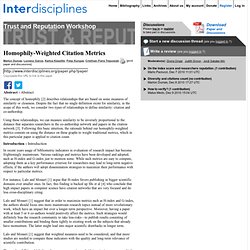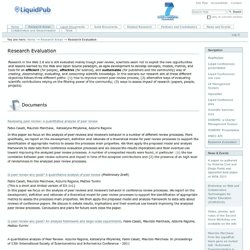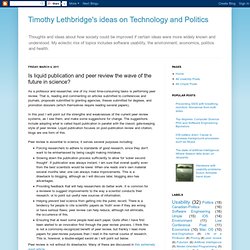

F1000 - Post-publication peer review of the biomedical literature. Features - Take a Tour - F1000. What is Web Science? - Web Science Trust. Research Areas — LiquidPub Project. Liquid Publications: Scientific Publications meet the WebChanging the way scientific knowledge is produced, disseminated, evalua.
Interdisciplines. Copy/paste this URL to link to this paper The concept of homophily [2] describes relationships that are based on some measures of similarity or closeness.

Despite the fact that no single definition exists for similarity, in the scope of this work, we consider two types of relationships to define similarity: citation and co-authorship. Using these relationships, we can measure similarity to be inversely proportional to the distance that separates researchers in the co-authorship network and papers in the citation network [3]. Following this basic intuition, the rationale behind our homophily-weighted metrics consists on using the distance on these graphs to weight traditional metrics, which in this particular paper is applied to citation count.
Abstract : Abstract The concept of homophily [2] describes relationships that are based on some measures of similarity or closeness. Introduction : Introduction Central Claim : Definitions and Rationale Definition 1. Definition 2. References 1. Research Evaluation — LiquidPub Project. Documents Reviewing peer review: a quantitative analysis of peer review Fabio Casati, Maurizio Marchese, Katsiaryna Mirylenka, Azzurra Ragone In this paper we focus on the analysis of peer reviews and reviewers behavior in a number of different review processes.

More specifically, we report on the development, definition and rationale of a theoretical model for peer review processes to support the identification of appropriate metrics to assess the processes main properties. We then apply the proposed model and analysis framework to data sets from conference evaluation processes and we discuss the results implications and their eventual use toward improving the analyzed peer review processes.
Is peer review any good? Fabio Casati, Maurizio Marchese, Azzurra Ragone, Matteo Turrini (This is a short and limited version of D3.1v1) In this paper we focus on the analysis of peer reviews and reviewers behavior in conference review processes. Is peer review any good? Tools Reseval Group comparison. University of Trento - Italy - UNITN-Eprints - Reviewing peer review: a quantitative analysis of peer review. Casati, Fabio and Marchese, Maurizio and Mirylenka, Katsiaryna and Ragone, Azzurra (2010) Reviewing peer review: a quantitative analysis of peer review.

UNSPECIFIED. (Unpublished) In this paper we focus on the analysis of peer reviews and reviewers behavior in a number of different review processes. More specifically, we report on the development, definition and rationale of a theoretical model for peer review processes to support the identification of appropriate metrics to assess the processes main properties. We then apply the proposed model and analysis framework to data sets from conference evaluation processes and we discuss the results implications and their eventual use toward improving the analyzed peer review processes.
Liquid Publications: Scientific Publications meet the Web — LiquidPub Project. Is liquid publication and peer review the wave of the future in science? As a professor and researcher, one of my most time-consuming tasks is performing peer review.

That is, reading and commenting on articles submitted to conferences and journals, proposals submitted to granting agencies, theses submitted for degrees, and promotion dossiers (which themselves require reading several papers). In this post I will point out the strengths and weaknesses of the current peer review systems, as I see them, and make some suggestions for change. The suggestions include adopting what is called liquid publication in parallel with the classic gate-keeping style of peer review. Liquid publication focuses on post-publication review and citation; blogs are one form of this.
Peer review is essential to science, it serves several purposes including: Forcing researchers to adhere to standards of good research, since they don't want to be embarrassed by being caught making mistakes.Slowing down the publication process sufficiently to allow for 'sober second thought'. Liquid Publications. A possible alternative to Peer Review and the ‘publish or perish’ logic of academic publishing URL = “In a nutshell, the approach proposes the following ideas and contributions: 1.

It introduces the notion of Liquid Publications (and, analogously, Liquid Textbooks) as evolutionary, collaborative, multi-faceted knowledge objects that can be composed and consumed at different levels of detail. 2. 3. Although the change advocated here is dramatic, the transition is not.